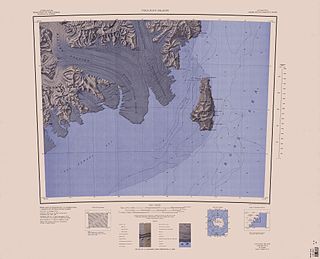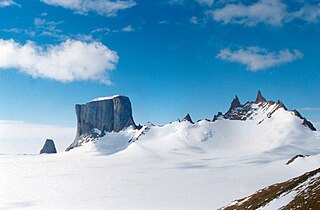
The Queen Elizabeth Range is a rugged mountain range of the Transantarctic Mountains System, located in the Ross Dependency region of Antarctica.

Borchgrevink Glacier is a large glacier in the Victory Mountains, Victoria Land, draining south between Malta Plateau and Daniell Peninsula, and thence projecting into Glacier Strait, Ross Sea, as a floating glacier tongue, the Borchgrevink Glacier Tongue, just south of Cape Jones. It was named by the New Zealand Geological Survey Antarctic Expedition, 1957–58, for Carsten Borchgrevink, leader of the British Antarctic Expedition, 1898–1900. Borchgrevink visited the area in February 1900 and first observed the seaward portion of the glacier.

Alamein Range is a mountain range lying west of Canham Glacier, in the Freyberg Mountains of Antarctica. Named in association with Lord Bernard Freyberg and the Second New Zealand Expeditionary Force by the Northern Party of New Zealand Geological Survey Antarctic Expedition (NZGSAE), 1963-64. The mountain range is situated on the Pennell Coast, a portion of Antarctica lying between Cape Williams and Cape Adare.
Jensen Glacier is a tributary glacier, about 10 nautical miles (20 km) long, flowing north between the Supporters Range and Lhasa Nunatak into Snakeskin Glacier, in Antarctica. It was named by the Advisory Committee on Antarctic Names for Kenard H. Jensen, a United States Antarctic Research Program meteorologist at South Pole Station in 1963.
Komsa Mountain is a 2,960-metre-high (9,700 ft) mountain located between Koms Glacier and Salen Mountain in the Sør Rondane Mountains of Antarctica. It was mapped by Norwegian cartographers in 1957 from air photos taken by U.S. Navy Operation Highjump, 1946–47, and named Komsa.
The Djupedalshausane Peaks are a group of peaks between the heads of Lunde Glacier and Djupedalen Valley in the Mühlig-Hofmann Mountains, Queen Maud Land. They were mapped by Norwegian cartographers from surveys and air photos by the Sixth Norwegian Antarctic Expedition (1956–60) and named Djupedalshausane.
Djupedalsleitet Saddle is an ice saddle between the head of Djupedalen Valley and Snuggerud Glacier, south of the Filchner Mountains in Queen Maud Land. It was mapped and name by Norwegian cartographers from surveys and air photos by the Sixth Norwegian Antarctic Expedition (1956–60).

The Freyberg Mountains are a group of mountains in Victoria Land, Antarctica, bounded by Rennick Glacier, Bowers Mountains, Black Glacier, and Evans Neve. Named for New Zealand's most famous General, Lord Bernard Freyberg, by the Northern Party of New Zealand Geological Survey Antarctic Expedition (NZGSAE), 1963-64. This mountain group includes the Alamein Range. These topographical features all lie situated on the Pennell Coast, a portion of Antarctica lying between Cape Williams and Cape Adare.
Fremantle Peak is a peak, 2,375 metres (7,800 ft) high, standing 0.4 nautical miles (0.7 km) northeast of the Dome, near the summit of Heard Island. It was surveyed in 1948 by the Australian National Antarctic Research Expeditions, and named by them after the port of Fremantle, the final point of embarkation for the expedition.

Hålisen Glacier is a cirque glacier between Halisrimen Peak and Halisstonga Peak in the Kurze Mountains of Queen Maud Land, Antarctica. It was mapped by Norwegian cartographers from surveys and air photos by the Sixth Norwegian Antarctic Expedition (1956–60) and named Hålisen.

Mount Hochlin is a large ice-topped mountain, 2,760 metres (9,060 ft) high, standing east of Festninga Mountain in the Mühlig-Hofmann Mountains of Queen Maud Land, Antarctica. It was mapped by Norwegian cartographers from surveys and air photos by the Sixth Norwegian Antarctic Expedition (1956–60) and named for L. Hochlin, a radio operator and dog driver with the expedition (1956–58).
The Huldreskorvene Peaks are a group of summit peaks and crags just north of Skorvehalsen Saddle and west of Tussenobba Peak in the Mühlig-Hofmann Mountains of Queen Maud Land, Antarctica. They were mapped by Norwegian cartographers from surveys and air photos by the Sixth Norwegian Antarctic Expedition (1956–61), and named by the Norwegians.
Slettfjellnutane Peaks are two small rock peaks about 2 nautical miles (3.7 km) north of Slettfjell on the Ahlmann Ridge in Queen Maud Land. Mapped by Norwegian cartographers from surveys and air photos by Norwegian-British-Swedish Antarctic Expedition (NBSAE) (1949–52), and named Slettfjellnutane because of their proximity to Slettfjell.
Snøhetta Dome is a dome-shaped elevation which is snow-covered except for a few rock exposures, situated 3 nautical miles (5.6 km) east of Hornet Peak in the Ahlmann Ridge of Queen Maud Land. It was mapped by Norwegian cartographers from surveys and air photos by the Norwegian-British-Swedish Antarctic Expedition (1949–52) and air photos by the Norwegian expedition of 1958–59, and named Snøhetta.
Snønutryggen is a broad, ice-covered ridge rising southeast of Snønutane Peaks in the Mühlig-Hofmann Mountains of Queen Maud Land. It was mapped by Norwegian cartographers from surveys and air photos by the Norwegian Antarctic Expedition (1956–60) and named Snønutryggen.
Horteriset Dome is a broad ice covered hill about 13 nautical miles (24 km) west of the southern part of the Weyprecht Mountains in Queen Maud Land, Antarctica. First photographed from the air by the Third German Antarctic Expedition (1938–39), it was mapped by Norwegian cartographers from surveys and air photos by the Sixth Norwegian Antarctic Expedition (1956–60) and named by them.
Remplingen Peak is a peak, 2,650 m, at the north end of Langfloget Cliff in the Muhlig-Hofmann Mountains, Queen Maud Land. Mapped by Norwegian cartographers from surveys and air photos by the Norwegian Antarctic Expedition (1956–60) and named Remplingen.
The Liljequist Heights are the heights about 2 nautical miles (4 km) south of the Grunehogna Peaks, in the Ahlmann Ridge of Queen Maud Land, Antarctica. They were mapped by Norwegian cartographers from surveys and air photos by the Norwegian–British–Swedish Antarctic Expedition (NBSAE) (1949–52) and air photos by the Norwegian expedition (1958–59). The heights are named for Gösta Hjalmar Liljequist, a Swedish meteorologist with the NBSAE.








